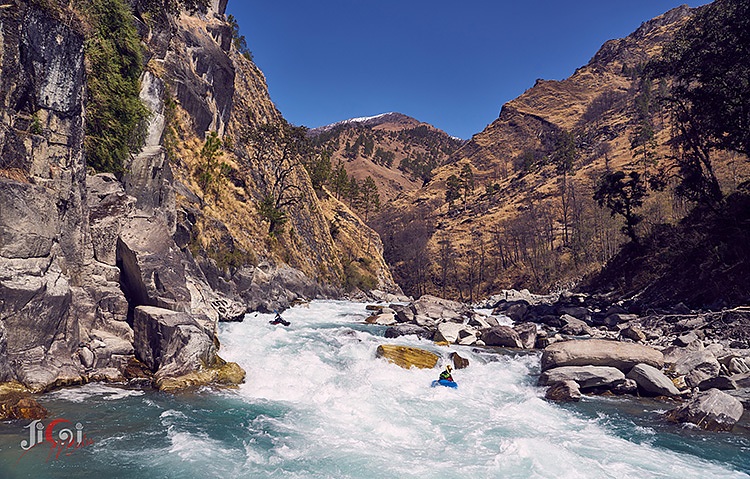
Written with contributions from Brett VandenHeuvel, Columbia Riverkeeper, and Christine Ellis, Deputy Director of Waccamaw Riverkeeper
In April 2015, a devastating earthquake shook Nepal and took over 8,000 lives. At the time, one Waterkeeper Organization was in Nepal. Bagmati River Waterkeeper Mausam Khanal, his organizational leader Megh Ale (now the Karnali River Waterkeeper), and their entire team of river guides and conservationists took unprecedented action to help rescue remote communities and rebuild Nepal. Because of their actions, the Waterkeeper family in Nepal has grown bigger, stronger, and more determined to save Nepal’s Himalayan Rivers.
From March 11-21, Columbia Riverkeeper Brett VandenHuevel and Waccamaw Riverkeeper Deputy Director Christine Ellis joined Waterkeeper Alliance’s Asia Regional Coordinator Min Zheng and myself in Nepal to help train and organize our growing network of Himalayan Waterkeepers, Affiliates, and partners, including over 200 Drukpa Kung Fu Nuns. We also supported the 2nd Nepal River Summit 2017, where over 250 local stakeholders and youth gathered to develop their knowledge of the conservation and management of Nepal’s rivers.
“Nepal is a place of contrasts: striking beauty and terrible pollution. Raw sewage pours into rivers, plastic is burned on the streets, and formerly clear rivers run brown,” said Brett VandenHeuvel. “The rivers of Nepal need a voice to speak for them. The Nepali Waterkeepers serve that role. In a place where environmental laws are rarely enforced, Waterkeepers will step up.”
There are currently five Waterkeeper Organizations in Nepal, on the Bagmati, Karnali, Trishuli, SunKoshi, and SetiGandaki Rivers, all founded by Nepal River Conservation Trust (NRCT). The threats to these rivers include severe pollution, from raw sewage and non-biodegradable trash, sand mining, and hydro dam projects. It will take an army of Waterkeepers to tackle the pollution and climate change threats to waterways in Nepal. Thankfully, the Waterkeeper network is growing quickly and making substantial progress in their communities. They have organized a world-class cleanup program with thousands of volunteers on the Bagmati River in Kathmandu. They have engaged smart and talented youth and they are recruiting Waterkeeper Affiliates to help protect clean water across Nepal.

At the 2nd Nepal River Summit 2017 – organized by NRCT, Nepal’s Youth Alliance Environment, and two major universities – over 250 local environmental scientists, public interest lawyers, students, and many prospective Waterkeepers and Affiliates joined together. Government officials, including the Minister for Population and Environment, and representatives from USAID and World Wildlife Fund also joined in Kathmandu.
This gathering of committed citizens was led by Megh Ale, one of the most powerful forces of nature that you can meet. As a young child, Megh would often escape to the river. He learned to kayak and raft and quickly became one of Nepal’s leading white water rafting guides – and one of its most outspoken river conservation advocates. Megh gathered his fellow guides and formed NRCT in 1995; today, they remain among the most powerful voices for Nepal’s rivers.
The Summit was held at a campsite on the the Trishuli River’s largest and most pristine beach, where as a young man Megh discovered his path as a guide and voice for rivers. The Trishuli is named after Trishula or the trident of Shiva—one of the most powerful Hindu gods. Millions of explorers experience the Trishuli River first as they make their way outside of Kathmandu to explore Nepal; Trishuli River Waterkeeper is currently advocating for Heritage River Status.
Megh and the Summit organizers ensured that we experienced the power of the river and its rapids; we arrived at camp after a two hour rafting trip with over 200 Summit participants who gathered to educate, inspire and develop an understanding of how to protect and preserve Nepal’s beautiful rivers and ecosystems. “Rafting on the Trishuli afforded us the opportunity to experience the river and for our diverse group to bond over water at the beginning of the 2nd Nepal River Summit,” said Christine Ellis. “The Trishuli could serve as a metaphor for the issues we face as river advocates: times of calmness and agreement, then times of discord and rough waters.”

Nepal’s first official National Rafting Team joined us at the Summit to show us the gorgeous landscapes that are threatened by a proposal for a mega dam project on the Karnali River. The Karnali is Nepal’s last free flowing river and its most pristine – descending from Mount Kailash, sacred to both Hindus and Buddhists, all the way to Nepal’s border with India. Nepal’s Rafting Team ran the first Nepali-only expedition to descend the river, and the first to engage with the indigenous community that calls it home. It would be criminal to destroy this beautiful lifestyle with the hydro dam project. Karnali River Waterkeeper is committed to keeping the river free flowing, and we can lend support by joining Karnali River Expeditions and helping the indigenous Nepali people to keep their land.
Just as impressive as the rafting team and guides, were the youth of Nepal. These young men and women know what their country has to offer them – even their social media feeds are filled with the beauty of Nepal’s natural wonders. This generation of young environmentalists is eager to become advocates for Nepal’s rivers and help their country prosper. They recognize that land and river conservation – and eco-tourism – have tremendous potential to directly provide for the people of Nepal. Waterkeeper Alliance is committed to strengthening a growing network of Waterkeeper Organizations and Affiliates in Nepal to help them achieve their vision for a sustainable Nepal.
Namaste.